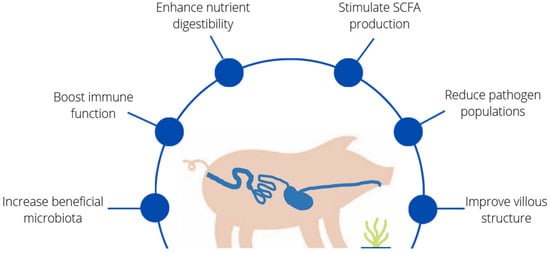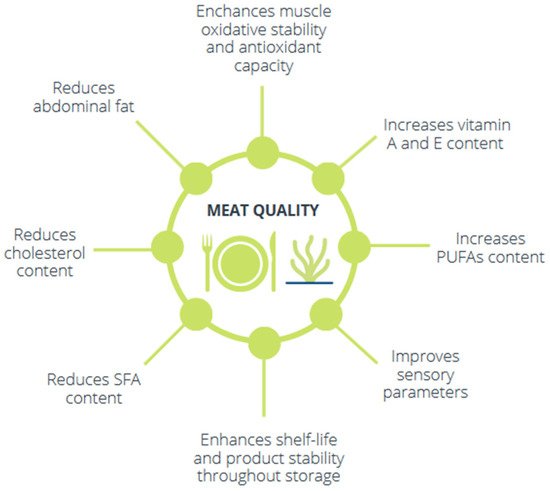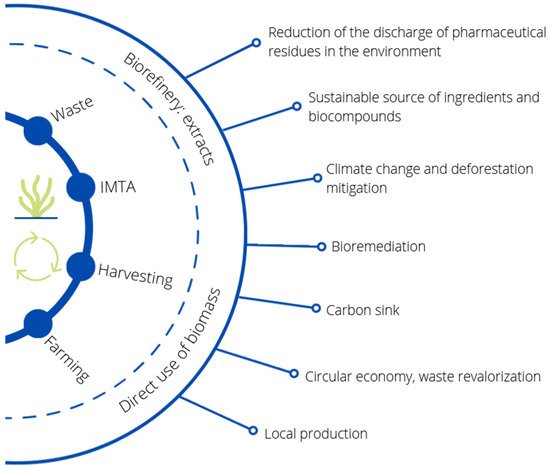2. Seaweed and Gut Health
Seaweed has traditionally been used in animal nutrition in some parts of the world—as fodder during periods of scarcity and also as a mineral supplement [
60,
61,
62]. However, the current interest in the use of algae in animal nutrition arises from the urgent need to search for new bioactive substances that can improve animal health and the sustainability of animal production [
63,
64,
65]. In this sense, seaweeds represent a very promising source of numerous beneficial substances, as they are very rich in polysaccharides with prebiotic potential [
66,
67,
68,
69].
The chemical composition and the bioactive metabolite content of seaweed/marine algae have been extensively studied, along with the variations related to species and genera, harvesting season, environmental conditions and geographical location (for a review, see [
60]), and it is outside of the scope of this paper to conduct a comprehensive review of these aspects. Overall, macroalgae are classified in three groups according to their pigmentation: green seaweeds (Chlorophyta), brown seaweeds (Phaeophyta) and red seaweeds (Rhodophyta) [
63,
70]. Although the composition is very variable, together, these seaweeds provide numerous nutrients of great interest (in animal nutrition). The protein content varies among groups, with red algae having the highest percentage (up to 47%) and brown algae the lowest (5–15%), and it is generally of very good quality in all types due to the high content of essential amino acids [
69]. Seaweeds are a rich source of minerals, as they contain high levels of potassium, sodium and calcium, as well as iron, zinc, iodine, manganese, copper, cobalt and selenium [
63,
71,
72] and also high levels of vitamins, especially vitamins A, C and E and the B group vitamins (B1, B2 and B12) [
71,
73]. Seaweeds also contain large amounts of PUFAs, particularly omega-3 and omega-6, which are present in a balanced ratio [
69,
71,
72]. They are also rich in polyphenolic compounds (such as flavonoids and tannins), which act as strong antioxidants [
69,
70,
71,
73].
The main current interest in the use of seaweeds in animal nutrition lies in their high contents of complex polysaccharides and oligosaccharides, which are not generally digested in the small intestine and are thus partially or fully fermented in the large intestine or colon, providing a rich source of dietary fibre (25–75% of DM) [
61,
71,
73]. Brown seaweeds contain soluble fibres such as alginates, fucoidans and laminarins; green seaweeds contain ulvans, galactans, xylans and mannans; and red seaweeds are mostly composed by agars, carrageenans, xylans and porphyran [
69,
74,
75,
76,
77]. Some of these polysaccharides, such as laminarins, fucoidans, alginates, galactans and ulvans, have been demonstrated to have prebiotic activity [
67,
71,
78], among other properties (
Table 1; [
74,
75]). These polysaccharides are fermented by and stimulate the growth of commensal bacteria and also inhibit the growth and adhesion of pathogens and improve gut architecture [
61,
76,
77]. Improved gut health is reflected at many levels, as the consumption of algae increases the absorption of nutrients and thus growth and animal welfare [
61,
63]. Some of these compounds also display immunomodulatory and anti-inflammatory activities [
71].
Table 1. Main polysaccharides of interest in macroalgae.
Very few studies have evaluated the inclusion of seaweed in the diets of rabbits, and in most of the studies, the main objective has been to evaluate the potential prebiotic effects on gut health. Two studies performed in Egypt [
72,
79] evaluated the effect of including whole algae (sun-dried) on the growth performance and gut health of growing rabbits. In both cases, the inclusion of 1%
Ulva lactuca had positive effects on the growth performance and digestive health parameters of rabbits. On the contrary, in a study conducted in Brazil [
80], in which rabbits were fed
Lithothammium flour (up to 1% of the diet), no significant effects on animal performance or digestive health were observed, even though the highest concentration of algae (1%) led to a decrease in the length and width of the villi. Finally, studies were recently conducted in Italy with the main objective of evaluating the effects of natural extracts from plants and algae (including polysaccharides from brown seaweeds) on the reproductive performance of does [
81], semen quality in bucks [
82] and zootechnical performance and antioxidant effects; although no significant effects on the reproductive endpoints were observed, the supplementation of the diets with algae improved the antioxidant status and fat metabolism in the animals. In a similar study carried out in Italy, the effect of natural extracts from plants and algae on the growth performance and meat quality parameters of growing rabbits was evaluated [
9,
10]. The long-term supplementation of lactating does and their offspring with brown seaweed and plant polyphenols (0.3 and 0.6%) improved growth performance, lowered cholesterol content and enhanced the oxidative stability and sensory quality of the meat, leading the researchers to conclude that a low dose of brown seaweed (
Laminaria spp.) and plant-extract supplementation (phenolic acid, hydroxycinnamic acids, tannins and flavonoids) could enhance growth performance and produced better-quality rabbit meat. Although none of these studies evaluated the gut health of rabbits, most indicated that seaweed consumption can potentially enhance growth performance and antioxidant status and produce better-quality meat.
On the contrary, a large body of research has been carried out in piglets to evaluate the inclusion of macroalgae and algal extracts (mainly laminarin and fucoidans) in the diet in the post-weaning period. Pig production faces problems similar to those of rabbit production related to dysbiosis during the post-weaning period, which was traditionally controlled with the use of antibiotic-medicated feed and supplementation with high levels of minerals (particularly copper and zinc) [
58]. The ban on (or limited use of) antibiotics has led to the need for feeding strategies in the post-weaning period that can re-establish the gut eubiosis lost at weaning, aimed at restoring the
Lactobacillus count, promoting the growth of beneficial bacteria that boost the mucosal immune system and lowering the proliferation of pathogenic bacteria [
83]. The pig farming sector already has some experience in using seaweed to improve the health and performance of piglets while avoiding the use of in-feed antibiotics (for a review, see [
58,
61,
63]). The results of the numerous studies carried out in this field are summarized in
Figure 1. Most studies have been performed with laminarin and fucoidan, which have been demonstrated to have many valuable properties. These compounds increase beneficial microbiota, enhance nutrient digestibility, improve villus structure, stimulate SCFA production, reduce pathogen populations and boost immune function, ultimately reducing post-weaning diarrhoea [
61,
65,
66,
84,
85,
86,
87,
88,
89,
90,
91,
92,
93,
94,
95,
96,
97].
Figure 1. Benefits of seaweeds on piglet gut health. Increase beneficial microbiota [
84,
85,
87,
88,
92,
93,
95], boost immune function [
85,
91,
95], enhance nutrient digestibility [
84,
85,
86,
87,
89,
96], stimulate SCFA production [
91,
97], reduce pathogen populations [
86,
87,
88,
92,
93,
95,
97], improve villous structure [
87,
97].
Given the experience with piglets, it seems reasonable to assume that rabbits could benefit from the supplementation of some algae or algae extracts enriched in polysaccharides to improve the health of the immature digestive system in the post-weaning period. This possibility deserves further study.
3. Seaweed and Meat Quality
Rabbit meat is a high-quality product due to its nutritive and dietetic properties [
1,
98]. It has a high protein content (of about 22%), characterised by high essential amino-acid levels. It is also a good source of potassium, phosphorous, selenium and B vitamins (being one of the richest sources of vitamin B12) and has a very low sodium content [
2,
8,
98]. Moreover, the fatty acid profile of rabbit meat is considered very healthy, because the meat contains lower levels of cholesterol and saturated fatty acids than other meats and is also very rich in PUFAs, which are well balanced between the n-3 and n-6 series [
99]. However, the high content of PUFAs makes this meat susceptible to oxidative deterioration and the generation of toxic compounds, which alter the sensorial properties and limit its shelf-life. Therefore, it is very important to increase the levels/balance of antioxidants in rabbit meat to guarantee its stability [
99]; this can be performed by including antioxidants (preferably of natural origin) in the animal feed.
Seaweeds are a rich source of antioxidants such as polyphenols and vitamins [
60,
71,
100,
101], and numerous studies have demonstrated their usefulness in improving muscle oxidative stability and antioxidant capacity in the main livestock species (
Figure 2). The inclusion of laminarin and fucoidan derived from
Laminaria digitata in piglet diets reduces lipid oxidation in the fresh meat [
11,
102] and also improves its antioxidant capacity [
102]. Another study [
103] has observed an effect on meat colour that may be related to an increase in antioxidant compounds [
101]. This effect has also been observed in ruminants [
104,
105] and in broiler chickens [
106].
Figure 2. Benefits of seaweeds on meat quality.
It has also been observed that some seaweeds
(L. digitata, L. japonica, A. nodosum) enhance the fatty acid profile of the meat by increasing the PUFA content and reducing the levels of saturated fatty acids and cholesterol, as observed in piglets [
12], ducks [
107] and cattle [
108]. A reduction in abdominal fat in broiler chickens has also been observed when fed a diet including
Ulva lactuca [
109]. The inclusion of laminarin and fucoidan in piglet diets also enhanced the visual sensory descriptors of the meat [
12] and reduced bacterial counts during storage [
102]. Finally, the high iodine content of some brown algae, easily transferred to animal tissues, has been proposed as a potential means of mitigating iodine deficiency in humans, with health benefits regarding the prevention of thyroid dysfunctions [
85].
Information about the capacity of seaweeds to improve meat quality in rabbits is scarce. The short- and long-term inclusion of
Laminaria spp. (0.3 and 0.6%) in rabbit diets was recently studied [
9,
10]. In a 42-day-long trial in growing rabbits, the vitamin A and E contents of muscle were improved, enhancing nutritional quality and oxidative stability; the sensory parameters were also enhanced. When lactating does were given the algal supplement, their offspring showed a reduction in cholesterol content and an increase in α-tocopherol and retinol contents, while the sensory quality of the meat was also improved.
Altogether, the available information indicates that the inclusion of macroalgae in the diet of rabbits could further improve the intrinsic properties of the meat and enhance its stability. This approach could be used as a marketing tool to help to generate a niche market for rabbit meat as a healthy food [
1].
4. Seaweed and Sustainable Animal Farming
Seaweed farming is increasing worldwide as part of the development of a sustainable economy [
110]. China and Indonesia, where harvesting or collecting algae from the natural environment is an ancient practice, are the major seaweed-producing countries, contributing 86.6% of global seaweed production [
60,
111]. Within Europe, France is also a top producer of algae [
111], and seaweed farming is currently expanding in Mediterranean countries [
112]. Seaweeds are used for multiple purposes, directly as animal feed and to produce biofertilizers. They can also be refined to extract some compounds of interest for the pharmaceutical, cosmetic and food industries, and by-products are used to produce biofuels or biofertilizers [
112,
113,
114,
115].
The use of macroalgae as an alternative to the use of antibiotics in animal production has many environmental benefits, beginning with the direct reduction in the discharge of pharmaceutical residues in the environment [
116]. The global consumption (228 countries) of antimicrobials in food animal production was estimated to be 63,151 (±1560) tonnes in 2010 and is expected to rise by 67% in 2030, almost doubling in BRICS countries [
117]. Between 40 and 90% (depending on the class of drugs) of the antibiotic dose administered is excreted as parent compounds in the active form in the faeces and urine, eventually reaching the environment and contaminating soils, water and plants [
118]. Once in the environment, antibiotic residues can have negative effects on biota at different trophic levels and on human health via the consumption of contaminated food and water, also contributing to increasing the resistant bacterial population and maintaining selective pressure that leads to the development and/or dissemination of resistance in different environmental compartments [
119,
120].
The inclusion of seaweed as an ingredient in animal feed provides essential amino acids, PUFAs, vitamins and minerals, antioxidants and soluble fibre, which together can improve animal health and contribute to low mortality rates and a reduction in antibiotic use [
58,
60]. The minimization of mortality rates would considerably reduce the environmental impact of rabbit farming by increasing its efficiency [
8,
121]. To achieve this goal, the development of diets that are well adapted to the post-weaning period together with improved farm management and hygienic conditions are crucial [
8,
14].
It is well known that the greatest environmental impact of monogastric farming is associated with feed production, especially commercial protein feeds such as soybean meal, which are associated with deforestation and emissions derived from transport [
8,
122]. Reduced protein intake and the substitution of part of the protein with other sources with lower environmental impact, such as macroalgae, would, therefore, contribute to mitigating damage to the environment and pollution due to nitrogen excretion [
8,
123,
124]. Moreover, in the context of population growth and limited sources, high rates of production of marine seaweeds could be achieved without the need for fresh water, arable land or fertilisation; seaweeds, therefore, represent an interesting source of ingredients and bioactive compounds for human and animal nutrition [
61,
97,
100,
123,
125].
Within sustainable farming systems, seaweed cultivation is of interest because of the ecosystem services that algae provide [
110]. Macroalgae possess bioremediation properties, as they are capable of minimising eutrophication by removing excess dissolved nutrients such as C, N and P [
126,
127]. They also remove heavy metals from water [
128] and act as a potential carbon sink that contributes to mitigating ocean acidification and climate change [
100,
114]. In this sense, seaweed cultivation has been proposed as a beneficial co-culture practice in aquaculture, in a new system called IMTA (integrated multi-trophic aquaculture), in order to reduce the environmental impact of fish and mussel production [
127]. Intensive mariculture produces large quantities of organic and inorganic pollutants that cause environmental deterioration [
126]. The IMTA system combines the cultivation of various species from different trophic levels and complementary ecosystem functions (fed species (fish/shrimp), filtering species (mussels/oysters/other molluscs) and extractive species (seaweeds)), so that the waste and nutrients derived from one culture can be reused and used for other species [
127,
129]. As a result, the whole system is less harmful to the environment [
126,
129], and total production is higher than that of monoculture systems, reaching higher biomass yield [
130] and better-quality products [
127].
Furthermore, some seaweeds such as
Ulva spp. grow uncontrollably on the coast and have some negative environmental impacts, leading to coastal degradation and problems for the fishing industry and tourism. Seaweed is removed regularly, thereby generating tons of marine macroalgal waste every year [
62,
69]. In addition, the seaweed industry also generates large amounts of waste during the transformation process. This waste could be revalorized for inclusion in animal feed, among other uses, providing benefits both to animal health and the economic viability of industries. This approach would create a circular economy model that would be beneficial in environmental, economic, social and animal welfare terms (
Figure 3) [
62,
129].
Figure 3. Environmental benefits of revalorizing seaweeds for animal feed.



